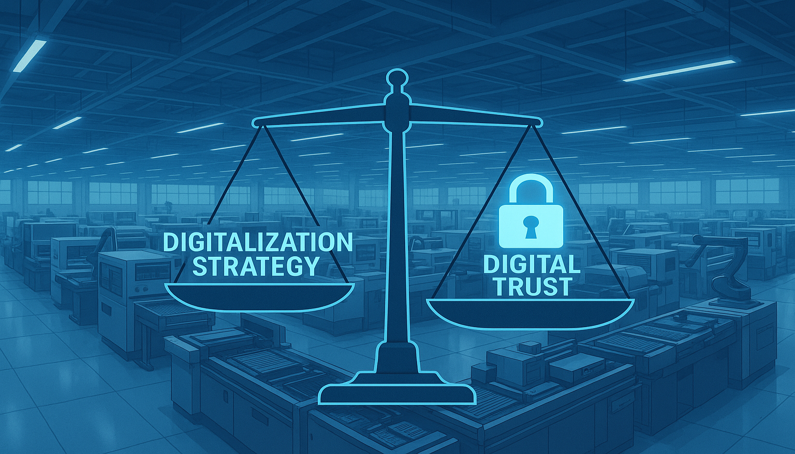
Want to future-proof your MOM strategy? Start with digital trust — and see why Hybrid SaaS makes all the difference.
Beyond Features: Why Digital Trust Is the New Currency in Manufacturing
In my role as Chief Sales Officer, I work closely with manufacturers in highly regulated, high-performance industries: medical devices, electronics, semiconductors, and aerospace. Across all these sectors, one truth has become evident: digital transformation fails where trust is lacking.
Today, digital trust is no longer an abstract IT concept. It's a hard business metric — one that affects uptime, compliance, adaptability, and ultimately: customer satisfaction.
This article explores how manufacturers can evaluate and build digital trust into their manufacturing operations management (MOM) strategies — and why Hybrid SaaS architectures are central to that equation.
1. Trust is rooted in operational performance
The most advanced system is irrelevant if it cannot be trusted to run reliably under pressure. In production environments with tight tolerances and regulatory oversight, even minor inconsistencies can lead to massive operational risks.
- 86% of manufacturing leaders cite system reliability as a top factor in their digital infrastructure decisions
(Source: Deloitte – 2024 Global Manufacturing Outlook) - A single hour of unplanned downtime costs manufacturers an average of $260,000
(Source: Aberdeen Strategy & Research)
Key takeaway: Trust is not just about software uptime. It’s about the absence of surprises during real-world execution.
2. The Cloud vs. On-Prem debate misses the point
Too often, strategic discussions get stuck in technical absolutes. Cloud-first vs. on-premise. Centralized vs. edge. In reality, the winning strategy is adaptive.
As CSO, I often see that clients aren't looking for "cloud" or "on-prem" — they want:
- Faster innovation cycles
- No disruptions to their critical operations
- Secure, transparent governance models
- Room to scale without breaking their legacy systems
Hybrid SaaS has emerged as a powerful response:
➤ Innovation delivered via the cloud
➤ Execution controlled securely on the shop floor
➤ Updates that do not risk runtime availability
“Hybrid deployment models allow manufacturers to leverage cloud capabilities while maintaining critical operations on premises, significantly reducing risk.”
— McKinsey Digital Manufacturing Report 2023
3. The Trust Equation: Visibility × Control × Resilience
To design for digital trust, manufacturers need to systematically manage three dimensions:
|
Dimension |
Description |
|
Visibility |
Real-time process transparency, end-to-end traceability, system health monitoring |
|
Control |
Role-based access, workflow ownership, change management processes |
|
Resilience |
Downtime tolerance, secure fallback mechanisms, SLA-enforced continuity |
Without all three, digital strategies will be seen as fragile or opaque — and adoption will suffer.
4. Building trust is a leadership responsibility
Digitalization isn't just an IT program — it's a transformation of how operations think, decide, and react.
As CSO, I often position MOM transformation as a leadership initiative because it touches multiple domains:
- Sales commitments and delivery reliability
- Operational responsiveness to change
- Customer perception of quality and control
- The employer brand in digital talent markets
To gain the confidence of both internal teams and external partners, we must articulate:
"Our systems are not only smart — they are stable.
Our transformation is not only fast — it is safe."
Conclusion
In the race toward digital manufacturing excellence, trust is the differentiator. And it’s not just earned by technology itself — it’s earned through architecture, transparency, and communication.
Hybrid SaaS is not a compromise. It’s a strategic response to the reality of modern operations: balancing flexibility, control, and resilience.
If you want to lead through change, you need more than features.
You need a foundation your customers, employees, and partners can believe in.
👉 Curious how digitally resilient your manufacturing organization is today?
Let’s explore your MOM strategy — and identify how Hybrid SaaS can help you scale with confidence.
📧 Contact our team to schedule a discovery session
Further Reading & References
- Deloitte, 2024 Global Manufacturing Outlook –
https://www2.deloitte.com - Aberdeen Strategy & Research, Cost of Downtime in Manufacturing – https://www.aberdeen.com
- McKinsey, Digital Manufacturing Transformation Report 2023 –
https://www.mckinsey.com - Siemens, Manufacturing Operations Management and the Digital Thread – https://plm.sw.siemens.com
- World Economic Forum, Building Trust in Cloud and Data Platforms – https://www.weforum.org
Authorʼs Note:This article is intended as a thought leadership piece. All data is sourced from reputable industry studies and reports as referenced above. For organizations seeking to move beyond isolated systems, the path to digital maturity is clear: invest in integration, foster a culture of innovation, and measure progress not just by technology, but by business outcomes.
About Jochen Stephan | Chief Sales Officer, znt-Richter Group:

Dynamic sales leader with over 25 years of B2B and B2P expertise in Manufacturing Operations Management (MOM), Corporate Performance Management and Financial Planning. Proven track record in driving revenue growth, building high-performing teams and fostering strategic partnerships. Seasoned lecturer at the Hochschule der Wirtschaft für Management (HDWM), delivering complex financial and performance-management topics to future business leaders.
